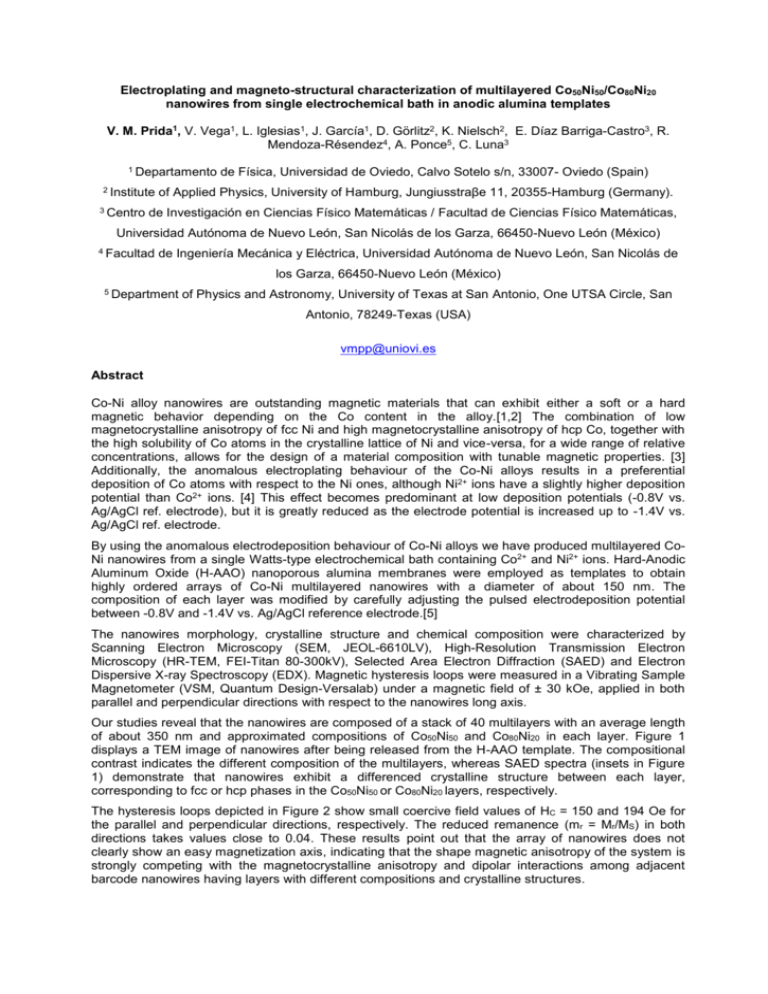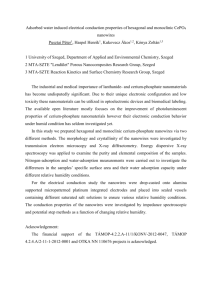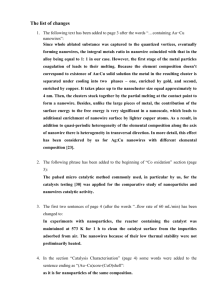2012_DE LA PRIDA PIDAL_VICTOR MANUEL_vmpp@uniovi
advertisement

Electroplating and magneto-structural characterization of multilayered Co50Ni50/Co80Ni20 nanowires from single electrochemical bath in anodic alumina templates V. M. Prida1, V. Vega1, L. Iglesias1, J. García1, D. Görlitz2, K. Nielsch2, E. Díaz Barriga-Castro3, R. Mendoza-Résendez4, A. Ponce5, C. Luna3 1 Departamento 2 Institute 3 Centro de Física, Universidad de Oviedo, Calvo Sotelo s/n, 33007- Oviedo (Spain) of Applied Physics, University of Hamburg, Jungiusstraβe 11, 20355-Hamburg (Germany). de Investigación en Ciencias Físico Matemáticas / Facultad de Ciencias Físico Matemáticas, Universidad Autónoma de Nuevo León, San Nicolás de los Garza, 66450-Nuevo León (México) 4 Facultad de Ingeniería Mecánica y Eléctrica, Universidad Autónoma de Nuevo León, San Nicolás de los Garza, 66450-Nuevo León (México) 5 Department of Physics and Astronomy, University of Texas at San Antonio, One UTSA Circle, San Antonio, 78249-Texas (USA) vmpp@uniovi.es Abstract Co-Ni alloy nanowires are outstanding magnetic materials that can exhibit either a soft or a hard magnetic behavior depending on the Co content in the alloy.[1,2] The combination of low magnetocrystalline anisotropy of fcc Ni and high magnetocrystalline anisotropy of hcp Co, together with the high solubility of Co atoms in the crystalline lattice of Ni and vice-versa, for a wide range of relative concentrations, allows for the design of a material composition with tunable magnetic properties. [3] Additionally, the anomalous electroplating behaviour of the Co-Ni alloys results in a preferential deposition of Co atoms with respect to the Ni ones, although Ni2+ ions have a slightly higher deposition potential than Co2+ ions. [4] This effect becomes predominant at low deposition potentials (-0.8V vs. Ag/AgCl ref. electrode), but it is greatly reduced as the electrode potential is increased up to -1.4V vs. Ag/AgCl ref. electrode. By using the anomalous electrodeposition behaviour of Co-Ni alloys we have produced multilayered CoNi nanowires from a single Watts-type electrochemical bath containing Co2+ and Ni2+ ions. Hard-Anodic Aluminum Oxide (H-AAO) nanoporous alumina membranes were employed as templates to obtain highly ordered arrays of Co-Ni multilayered nanowires with a diameter of about 150 nm. The composition of each layer was modified by carefully adjusting the pulsed electrodeposition potential between -0.8V and -1.4V vs. Ag/AgCl reference electrode.[5] The nanowires morphology, crystalline structure and chemical composition were characterized by Scanning Electron Microscopy (SEM, JEOL-6610LV), High-Resolution Transmission Electron Microscopy (HR-TEM, FEI-Titan 80-300kV), Selected Area Electron Diffraction (SAED) and Electron Dispersive X-ray Spectroscopy (EDX). Magnetic hysteresis loops were measured in a Vibrating Sample Magnetometer (VSM, Quantum Design-Versalab) under a magnetic field of ± 30 kOe, applied in both parallel and perpendicular directions with respect to the nanowires long axis. Our studies reveal that the nanowires are composed of a stack of 40 multilayers with an average length of about 350 nm and approximated compositions of Co50Ni50 and Co80Ni20 in each layer. Figure 1 displays a TEM image of nanowires after being released from the H-AAO template. The compositional contrast indicates the different composition of the multilayers, whereas SAED spectra (insets in Figure 1) demonstrate that nanowires exhibit a differenced crystalline structure between each layer, corresponding to fcc or hcp phases in the Co50Ni50 or Co80Ni20 layers, respectively. The hysteresis loops depicted in Figure 2 show small coercive field values of HC = 150 and 194 Oe for the parallel and perpendicular directions, respectively. The reduced remanence (mr = Mr/MS) in both directions takes values close to 0.04. These results point out that the array of nanowires does not clearly show an easy magnetization axis, indicating that the shape magnetic anisotropy of the system is strongly competing with the magnetocrystalline anisotropy and dipolar interactions among adjacent barcode nanowires having layers with different compositions and crystalline structures. References [1] Talapatra S, Tang X, Padi M, Kim T, Vajtai R, Sastry G V S., Shma M, Deevi S C, Ajayan, P M, J. Mater. Sci. 44 (2009) 2271. [2] Vivas L G, Vázquez M, Escrig J, Allende S, Altbir D, Leitao D C, Araujo J P, Phys. Rev. B 85 (2012) 035439. [3] Cheng S L, Huang C N, Synth. React. Inorg., Met.-Org., Nano-Met. Chem. 38 (2008) 475. [4] Tian L, Xu J, Qiang C, Appl. Surf. Sci. 257 (2011) 4689. [5] Clime L, Zhao S Y, Chen P, Normandin F, Roberge H, Veres T, Nanotechnology 18 (2007) 435709. Figures Figure 1: HR-TEM image of multilayered Co50Ni50/Co80Ni20 nanowires. The insets show SAED spectra of two layers with different compositions, evidencing the change in their crystalline structures. 1.0 Parallel Perpendicular 0.0 0.05 M/MS M/MS 0.5 0.00 -0.5 -0.05 -0.2 -1.0 -10 0.0 0.2 Magnetic Field (kOe) -5 0 5 10 Magnetic Field (kOe) Figure 2. Hysteresis loops of multilayered Co50Ni50/Co80Ni20 nanowires in the parallel and perpendicular directions with respect to the nanowires long axis. The inset shows an enlargement at the low field region. TOPIC: Nanomagnetism and Spintronics






